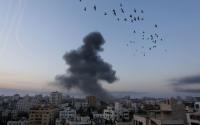1 July 2008Tom Dispatch
On March 19, 2003, as his shock-and-awe campaign against Iraq was being launched, George W. Bush addressed the nation. "My fellow citizens," he began, "at this hour, American and coalition forces are in the early stages of military operations to disarm Iraq, to free its people and to defend the world from grave danger." We were entering Iraq, he insisted, "with respect for its citizens, for their great civilization and for the religious faiths they practice. We have no ambition in Iraq, except to remove a threat and restore control of that country to its own people."
Within weeks, of course, that "great civilization" was being looted, pillaged, and shipped abroad. Saddam Hussein's Baathist dictatorship was no more and, soon enough, the Iraqi Army of 400,000 had been officially disbanded by L. Paul Bremer, the head of the occupying Coalition Provisional Authority and the President's viceroy in Baghdad. By then, ministry buildings -- except for the oil and interior ministries -- were just looted shells. Schools, hospitals, museums, libraries, just about everything that was national or meaningful, had been stripped bare. Meanwhile, in their new offices in Saddam's former palaces, America's neoconservative occupiers were already bringing in the administration's crony corporations -- Halliburton and its subsidiary KBR, Bechtel, and others -- to finish off the job of looting the country under the rubric of "reconstruction." Somehow, these "administrators" managed to "spend" $20 billion of Iraq's oil money, already in the "Development Fund for Iraq," even before the first year of occupation was over -- and to no effect whatsoever. They also managed to create what Ed Harriman in the London Review of Books labeled "the least accountable and least transparent regime in the Middle East." (No small trick given the competition.)
Before the Sunni insurgency even had a chance to ramp up in 2003, they were already pouring billions of U.S. tax dollars into what would become their massive military mega-bases meant to last a millennium, and, of course, they were dreaming about opening Iraq's oil industry to the major oil multinationals and to a privatized future as an oil spigot for the West.
On May 1, 2003, six weeks after he had announced his war to the nation and the world, the President landed on the deck of the USS Abraham Lincoln, an aircraft carrier returning from the Persian Gulf where its planes had just launched 16,500 missions and dropped 1.6 million pounds of ordnance on Iraq. From its flight deck, he spoke triumphantly, against the backdrop of a "Mission Accomplished" banner, assuring Americans that we had "prevailed." "Today," he said, "we have the greater power to free a nation by breaking a dangerous and aggressive regime. With new tactics and precision weapons, we can achieve military objectives without directing violence against civilians." In fact, according to Human Rights Watch, the initial shock-and-awe strikes he had ordered killed only civilians, possibly hundreds of them, without touching a single official of Saddam Hussein's "regime."
Who's Counting Now?






